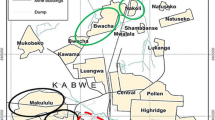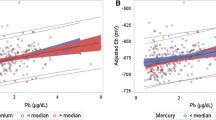Abstract
Genetic factors influence whole blood lead (Pb-B) concentrations in lead exposed subjects. This study aimed at examining the combined effects (haplotype analysis) of three polymorphisms (BsmI, ApaI and FokI) in vitamin D receptor (VDR) gene on Pb-B and on the concentrations of lead in plasma (Pb-P), which is more relevant to lead toxicity, in 150 environmentally exposed subjects. Genotypes were determined by RFLP, and Pb-P and Pb-B were determined by inductively coupled plasma mass spectrometry and by graphite furnace atomic absorption spectrometry, respectively. Subjects with the bb (BsmI polymorphism) or ff (FokI polymorphism) genotypes have lower B-Pb than subjects in the other genotype groups. Subjects with the aa (ApaI polymorphism) or ff genotypes have lower P-Pb than subjects in the other genotype groups. Lower Pb-P, Pb-B, and %Pb-P/Pb-B levels were found in subjects with the haplotype combining the a, b, and f alleles for the ApaI, BsmI, and FokI polymorphisms, respectively, compared with the other haplotype groups, thus suggesting that VDR haplotypes modulate the circulating levels of lead in exposed subjects.


Similar content being viewed by others
References
Arai H, Miyamoto K, Taketani Y, Yamamoto H, Iemori Y, Morita K, Tonai T, Nishisho T, Mori S, Takeda E (1997) A vitamin D receptor gene polymorphism in the translation initiation codon: effect on protein activity and relation to bone mineral density in Japanese women. J Bone Miner Res 12:915–921
Balding DJ (2006) A tutorial on statistical methods for population association studies. Nat Rev Genet 7:781–791
Barbosa F Jr, Tanus-Santos JE, Gerlach RF, Parsons PJ (2005) A critical review of biomarkers used for monitoring human exposure to lead: advantages, limitations, and future needs. Environ Health Perspect 113:1669–1674
Barbosa F Jr, Ramires I, Rodrigues MH, Saint’ Pierre TD, Curtius AJ, Buzalaf MR, Gerlach RF, Tanus-Santos JE (2006a) Contrasting effects of age on the plasma/whole blood lead ratio in men and women with a history of lead exposure. Environ Res 102:90–95
Barbosa F Jr, Sartorio JTC, Gerlach RF, Tanus-Santos JE (2006b) Clinical evidence for lead-induced inhibition of nitric oxide formation. Arch Toxicol 80:811–816
Barbosa Jr F, Gerlach RF, Tanus-Santos JE (2006c) Matrix metalloproteinase- 9 activity in plasma correlates with plasma and whole blood lead concentrations. Basic Clin Pharmacol Toxicol 98:559–564
Barbosa Jr F, Sandrim VC, Uzuelli JA, Gerlach RF, Tanus-Santos JE (2006d) eNOS genotype-dependent correlation between whole blood lead and plasma nitric oxide products concentrations. Nitric Oxide 14:58–64
Bogden JD, Kemp FW, Han S, Murphy M, Fraiman M, Czerniach D, Flynn CJ, Banua ML, Scimone A, Castrovilly L et al (1995) Dietary calcium and lead interact to modify maternal blood pressure, erythropoiesis, and fetal and neonatal growth in rats during pregnancy and lactation. J Nutr 125:990–1002
Cake KM, Bowins RJ, Vaillancourt C, Gordon CL, McNutt RH, Laporte R, Webber CE, Chettle DR (1996) Partition of circulating lead between serum and red cells is different for internal and external sources of lead. Am J Ind Med 29:440–445
Chuang HY, Yu KT, Ho CK, Wu MT, Lin GT, Wu TN (2004) Investigations of vitamin D receptor polymorphism affecting workers’ susceptibility to lead. J Occup Health 46:316–322
Crawford DC, Nickerson DA (2005) Definition and clinical importance of haplotypes. Annu Rev Med 56:303–320
Curran JE, Vaughan T, Lea RA, Weinstein SR, Morrison NA, Griffiths LR (1999) Association of A vitamin D receptor polymorphism with sporadic breast cancer development. Int J Cancer 83:723–726
Fullmer CS (1991) Intestinal calcium and lead absorption: effects of dietary lead and calcium. Environ Res 54:159–169
Fullmer CS (1992) Intestinal interactions of lead and calcium. Neurotoxicology 13:799–807
Haynes EN, Kalkwarf HJ, Hornung R, Wenstrup R, Dietrich K, Lanphear BP (2003) Vitamin D receptor Fok1 polymorphism and blood lead concentration in children. Environ Health Perspect 111:1665–1669
Hernandez-Avila M, Smith D, Meneses F, Sanin LH, Hu H (1998) The influence of bone and blood lead on plasma lead levels in environmentally exposed adults. Environ Health Perspect 106:473–477
Montenegro MF, Barbosa F Jr, Sandrim VC, Gerlach RF, Tanus-Santos JE (2006) A polymorphism in the delta-aminolevulinic acid dehydratase gene modifies plasma/whole blood lead ratio. Arch Toxicol 80:394–398
Morrison NA, Qi JC, Tokita A, Kelly PJ, Crofts L, Nguyen TV, Sambrook PN, Eisman JA (1994) Prediction of bone density from vitamin D receptor alleles. Nature 367:284–287
Norman AW (2006) Minireview: vitamin D receptor: new assignments for an already busy receptor. Endocrinology 147:5542–5548
Onalaja AO, Claudio L (2000) Genetic susceptibility to lead poisoning. Environ Health Perspect 108:23–28
Pounds JG (1984) Effect of lead intoxication on calcium homeostasis and calcium-mediated cell function: a review. Neurotoxicology 5:295–331
Pounds JG, Long GJ, Rosen JF (1991) Cellular and molecular toxicity of lead in bone. Environ Health Perspect 91:17–32
Rabinowitz MB (1991) Toxicokinetics of bone lead. Environ Health Perspect 91:33–37
Schutz A, Bergdahl IA, Ekholm A, Skerfving S (1996) Measurement by ICP-MS of lead in plasma and whole blood of lead workers and controls. Occup Environ Med 53:736–740
Schwartz BS, Lee BK, Lee GS, Stewart WF, Simon D, Kelsey K, Todd AC (2000) Associations of blood lead, dimercaptosuccinic acid-chelatable lead, and tibia lead with polymorphisms in the vitamin D receptor and [delta]-aminolevulinic acid dehydratase genes. Environ Health Perspect 108:949–954
Schwartz BS, Stewart WF, Kelsey KT, Simon D, Park S, Links JM, Todd AC (2000) Associations of tibial lead levels with BsmI polymorphisms in the vitamin D receptor in former organolead manufacturing workers. Environ Health Perspect 108:199–203
Smith D, Hernandez-Avila M, Tellez-Rojo MM, Mercado A, Hu H (2002) The relationship between lead in plasma and whole blood in women. Environ Health Perspect 110:263–268
Stephens M, Smith NJ, Donnelly P (2001) A new statistical method for haplotype reconstruction from population data. Am J Hum Genet 68:978–989
Theppeang K, Schwartz BS, Lee BK, Lustberg ME, Silbergeld EK, Kelsey KT, Parsons PJ, Todd AC (2004) Associations of patella lead with polymorphisms in the vitamin D receptor, delta-aminolevulinic acid dehydratase and endothelial nitric oxide synthase genes. J Occup Environ Med 46:528–537
Uitterlinden AG, Fang Y, Van Meurs JB, Pols HA, Van Leeuwen JP (2004a) Genetics and biology of vitamin D receptor polymorphisms. Gene 338:143–156
Uitterlinden AG, Fang Y, van Meurs JB, van Leeuwen H, Pols HA (2004b) Vitamin D receptor gene polymorphisms in relation to Vitamin D related disease states. J Steroid Biochem Mol Biol 89–90:187–193
Valdivielso JM, Fernandez E (2006) Vitamin D receptor polymorphisms and diseases. Clin Chim Acta 371:1–12
Weaver VM, Lee BK, Todd AC, Jaar BG, Ahn KD, Wen J, Shi W, Parsons PJ, Schwartz BS (2005a) Associations of patella lead and other lead biomarkers with renal function in lead workers. J Occup Environ Med 47:235–243
Weaver VM, Schwartz BS, Jaar BG, Ahn KD, Todd AC, Lee SS, Kelsey KT, Silbergeld EK, Lustberg ME, Parsons PJ, Wen J, Lee BK (2005b) Associations of uric acid with polymorphisms in the delta-aminolevulinic acid dehydratase, vitamin D receptor, and nitric oxide synthase genes in Korean lead workers. Environ Health Perspect 113:1509–1515
Weaver VM, Lee BK, Todd AC, Ahn KD, Shi W, Jaar BG, Kelsey KT, Lustberg ME, Silbergeld EK, Parsons PJ, Wen J, Schwartz BS (2006) Effect modification by delta-aminolevulinic acid dehydratase, vitamin D receptor, and nitric oxide synthase gene polymorphisms on associations between patella lead and renal function in lead workers. Environ Res 102:61–69
Wetmur JG, Kaya AH, Plewinska M, Desnick RJ (1991) Molecular characterization of the human delta-aminolevulinate dehydratase 2 (ALAD2) allele: implications for molecular screening of individuals for genetic susceptibility to lead poisoning. Am J Hum Genet 49:757–763
Ye XB, Wu CE, Fu H, Yang SL, Lu YW, Ni WM (2003) Associations of blood lead levels, kidney function, and blood pressure with delta-aminolevulinic acid dehydratase and vitamin D receptor gene polymorphisms. Toxicol Mech Methods 13:139–146
Zhou Y, Zanao RA, Barbosa F, Parsons PJ, Krug FJ (2002) Investigations on a W-Rh permanent modifier for the detection of Pb in blood by electrothermal atomic absorption spectrometry. Spectrochim Acta B 57:1291–1300
Acknowledgments
This study was funded by Fundação de Amparo a Pesquisa do Estado de São Paulo (FAPESP-Brazil) and Conselho Nacional de Desenvolvimento Científico e Tecnológico (CNPq-Brazil).
Author information
Authors and Affiliations
Corresponding author
Rights and permissions
About this article
Cite this article
Rezende, V.B., Barbosa, F., Montenegro, M.F. et al. Haplotypes of vitamin D receptor modulate the circulating levels of lead in exposed subjects. Arch Toxicol 82, 29–36 (2008). https://doi.org/10.1007/s00204-007-0231-4
Received:
Accepted:
Published:
Issue Date:
DOI: https://doi.org/10.1007/s00204-007-0231-4




